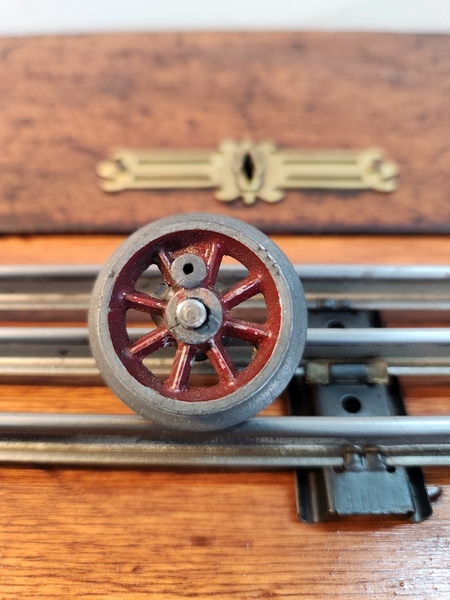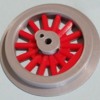Hello, Has anyone tried to cast their own spoked driver wheels similar to the one shown below? I haven't been able to find an 8 spoked version anywhere for my early American Flyer steam loco. I've tried Portline, Henning, Trainz, ebay, and others. I was thinking that it might not be too difficult to cast my own in zinc with an open mold using green sand. After, it could be finished in a lathe. Although it wouldn't be a 100% accurate copy on the unseen back side, it would be functional and a duplicate where it counts, plus I figure it would be a lot easier than making a 2 part mold. Thoughts?
Replies sorted oldest to newest
Not sure how durable the zinc tire would be. If you have access to a lathe, you could turn down the zinc casting to just the driver center, turn a separate tire from steel, and press together. Maybe even cheat and use Loctite.
As far as the 1-part mold, you can face the back of the casting flat on the lathe.
Ken, do you know what the originals were made from? They are not magnetic. Your idea about making it from 2 pieces is not bad, but I wonder if a zinc alloy, like ZAMAK, would give sufficient wear resistance to make it from 1 piece?
If they're a standard size rim, you might be able to get the steel tire from Henning's and solve that problem.
I’m not too sure how a sand cast mold would reproduce such a wheel,……I don’t know for sure, but I’d think the resolution is gonna be very granular in appearance, and you’re not planning on machining the spokes……IMO, to have as little flash as possible, or over pour, that pour would have to be pretty precise…..hence why stuff like that is injection molded in a set of blocks…..might look into a putty mold making kit that can handle molten zinc…..if something like that exists on the DIY level,….
Pat
EBay item 394619131578 has the same wheels. You should read up on making RTV silicone molds. To me they are easier than sand casting and you can use the same mold several times. j
I have been experimenting with 3D printed wheels. I have been testing a McCoy Steam Engine with a 3D printed front truck. So far it seems to function OK. I have printed a set of drive wheels and am waiting for time to run a test. The power ground will be picked up from the tender since the drive wheels are insulated. The idea from gunrunnerjohn of using a steel tire also sounds interesting.
Attachments
@David Nissen posted:I have been experimenting with 3D printed wheels. I have been testing a McCoy Steam Engine with a 3D printed front truck. So far it seems to function OK. I have printed a set of drive wheels and am waiting for time to run a test. The power ground will be picked up from the tender since the drive wheels are insulated. The idea from gunrunnerjohn of using a steel tire also sounds interesting.
What material are you printing these in? …..there are metal 3D printers, not sure the cost factor though, ….I’ve worked with some 3D metal printed parts in stainless, and the parts are as hard as darn it,….I’d t think that material would make an ideal wheel,…especially slip fit, & pre set for a set screw??…..
Pat
Composite filaments are about twice the price of regular filaments.... so, they are not expensive (40-80 bucks for a Kilo). Carbon Fiber PETG would be very strong with excellent wear resistance. Stainless Steel PLA is also very strong... but, brittle and may snap if press fitting is employed. Stainless PLA is about 2-3 times heavier (depending on metal % content of the filament) than regular PLA so you would have to purchase 2-3 times as much filament as compared to Carbon Fiber PETG. If the wheel weighs 10 grams... you would get 100 wheels from a kilo of Carbon Fiber PETG.
@Dennis-LaRock posted:Composite filaments are about twice the price of regular filaments.... so, they are not expensive (40-80 bucks for a Kilo). Carbon Fiber PETG would be very strong with excellent wear resistance. Stainless Steel PLA is also very strong... but, brittle and may snap if press fitting is employed. Stainless PLA is about 2-3 times heavier than regular PLA so you would have to purchase 2-3 times as much filament as compared to Carbon Fiber PETG.
A buddy of mine made me a 3D stainless part Dennis, and I found it to be as hard as darn it,….he actually sent 2 because 1 got warped in the printing process, so he sent it anyways for practicing on, drilling, cutting, fabricating, etc,…..maybe like you said, a press fit would shatter it, but lord, I could barely machine the part,…..it didn’t want to drill, cut, or be milled….could that threaded hole in the above image be integrated into a 3D made part? ….if it were to be made 3D stainless, ain’t no way to drill & tap for a set screw afterwards……that I know of anyways…..
Pat
Pat, nope. You cannot get that sort of detail with an FDM printer... so, you would have to tap the hole. Steel filaments in general are not recommended for stress bearing objects i.e., screws, threaded taps etc. The PLA itself is as hard as the dickens but it is extremely brittle and doesn't easily lend itself to tapping. Filaments such as ABS, Nylon and PETG are very, very strong and have 'some' give. You could certainly print a composite stainless tire with a tight fit and and glue/retaining compound it to the wheel.
The 3D printed drive wheels above were printed with PLA. The threaded holes for the set screws and the drive rods were tapped after the wheel was printed. I have found that PLA taps well. I have had trouble tapping TPU and nylon. The set screws are at a slight angle so the tap can reach over the rim of the wheel.
I have found that holes for axles must be cleaned up with a drill to be accurate. The drill must be turned very slow (by hand) as higher speeds cause the PLA to melt and adhere to the drill, making a mess of the hole.
I have been using PLA as a bearing surface with motor side frames with good success. The only problems I have had were when I oiled the PLA bearing surface. More tests are required using oil with PLA.
I am concerned about how well the set screws will work in the PLA. Another test that I want to try is to make a rounded triangular hole that can be pressed onto an axle without so much stress on the PLA hub.
PCBWay may be able to 3D print them for you if you're looking for metal.
PLA is a great material in my opinion. It has it's faults but every material does. What oil did you use on the PLA?







